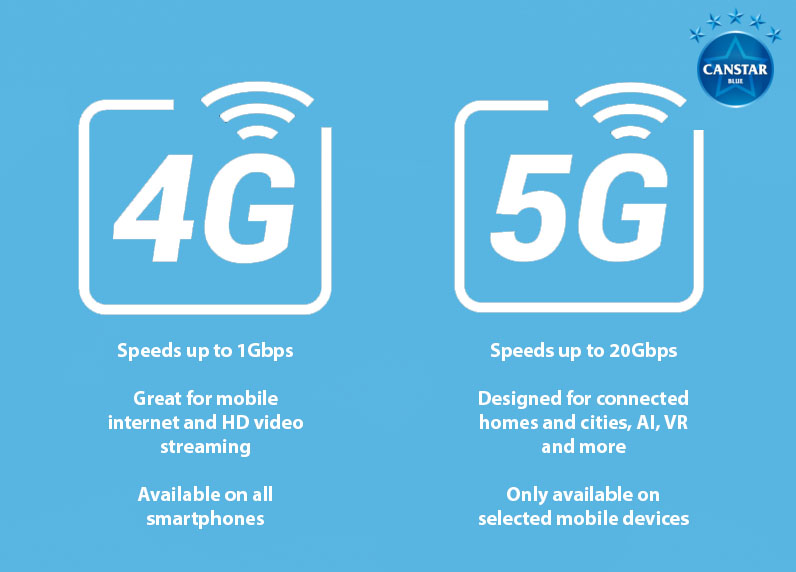If you’re happy using 5G networks, you may be wondering just how 4G is different. Fortunately, we’ve answered some of your most-asked questions about 5G and 4G, covering everything from speeds, to prices, to network safety. Read on for Canstar Blue’s simple guide to 5G vs. 4G in Australia.
In this guide:
- What do ‘5G’ and ‘4G’ mean?
- How is 5G different from 4G?
- How much faster is 5G?
- When will I get 5G in Australia?
- Which phones can use 5G?
- Can I get 5G broadband?
- Does 5G cost more than 4G?
- Is 5G safe?
What do we mean by ‘5G’ and ‘4G’?
The terms ‘5G’ and ‘4G’ refer to generations of mobile network technology. A ‘generation’ is a term that categorises major developments in how these mobile networks operate and transmit information, such as a move to a different frequency, a jump in speed, or a change in how that technology is used.
4G is the fourth generation of mobile network technology, the successor to 3G. Likewise, 5G refers to the fifth generation, and the next step up from 4G in terms of speed, performance, and applications in everyday life.
To sum up each generation so far:
- 1G: The first generation of mobile network, 1G was an analog two-way calling system that is now obsolete.
- 2G: The first mobile network to send digital radio signals, this generation brought us text and picture messages over mobile. 2.5G, or GPRS, also allowed mobile phones to send and receive emails and access the internet.
- 3G: The generation to make mobile internet faster and easier, its ability to transmit more data enabled touch-screen smartphones to go mainstream.
- 4G: The first generation to focus on data over voice calls, offering speeds 10 times faster than 3G and supporting more intensive activity such as high-definition video streaming.
- 5G: The newest generation of mobile, designed for super-fast speeds, more network capacity, and to enable technology such as smart homes, AI and connected vehicles.
How is 5G different from 4G?
The big differences between 4G and 5G are speed, latency, and bandwidth. Theoretically, 5G can reach speeds 20 times faster than 4G, although it’s likely to be a while before we see anything that impressive in Australia. 5G will send and receive data much faster, reduce lag on video calls and gaming, and allow more users to connect at once with less congestion – perfect for activities such as virtual reality, tele-medicine and tele-learning, and even self-driving cars.

This is achieved through a combination of improved technology, updated infrastructure, and utilising new wireless frequencies. In Australia, the three mobile network providers – Telstra, Optus, and Vodafone – have each prepared for 5G by rolling out software and hardware updates, including upgrading existing mobile base stations. Currently, 5G is offered on the same mid-range radio frequencies as 3G and 4G (below 6 Gigahertz, or GHz), and network providers plan to re-purpose old and out-of-use 2G spectrum to further expand 5G coverage.
As of 2022, Telstra and Optus have also begun to launch on higher frequencies of between 30GHz and 300GHz, known as millimetre wave or ‘mmWave’. This will enable even faster speeds over shorter distances, so will be ideal in high-traffic areas such as central business districts and airports.
When mmWave does roll out more extensively, it may mean that telcos build more low-power small cells to support it. Despite what you may have heard, there won’t be 5G towers built on every street; instead, small cells with a short signal range may be deployed in densely populated or commercial areas to help boost speeds and capacity. This isn’t guaranteed, however, and will depend on how each provider’s 5G expansion progresses.
While 5G outstrips 4G in terms of performance and speed, it’s not set to replace the fourth-generation network anytime soon. 4G will continue to operate in areas where 5G can’t reach or isn’t yet live, and will both support and be enhanced by the 5G rollout. Even if your town or suburb isn’t covered by 5G, you may see improvements in your current 4G connection thanks to the 5G-ready upgrades your telco makes to its existing towers and network infrastructure.
5G vs 4G Speed: How much faster is 5G?
Currently, 4G mobile networks in Australia offer a maximum speed of around 1Gbps (one gigabit per second). You’re unlikely to see anything close to that in your day-to-day use, but 4G speeds do regularly outperform fixed-line broadband networks like the NBN.
4G speeds
According to research firm OpenSignal’s October 2023 report, the average download speeds experienced for each of the three networks were:
- Telstra speeds: 57.5Mbps (megabits per second)
- Optus speeds: 60.1Mbps
- Vodafone speeds: 50.5Mbps
These results include the averages of 3G, 4G and 5G networks. Depending on your location and network, your real-world results could vary greatly.
5G speeds
5G has become more common across Australia, and we now have more data on average speeds.
Open Signal’s October 2023 mobile report listed the following average download speeds for Optus, Telstra and Vodafone’s 5G networks:
- Optus speeds: 226.8Mbps
- Telstra speeds: 201.9Mbps
- Vodafone speeds: 102.5Mbps
When will I get 5G in Australia?
Telstra, Optus and Vodafone are currently rolling out 5G coverage across all major Australian cities.
To determine if 5G is available in your area, you’ll need to check Telstra, Optus and Vodafone’s 5G coverage maps, or contact your telco directly. One thing to remember is that these maps only indicate approximate coverage, and signal strength and speeds may vary; you may also find you can’t connect to 5G indoors, as maps reflect outdoor 5G availability.
If you are lucky enough to live or work in a 5G-ready area, you’ll still need a 5G-capable device in order to use the network. Your old iPhone or Galaxy handset simply won’t cut it, but luckily 5G phones and hubs are now widely available in Australia.

Which phones can use 5G?
All new smartphones are compatible with 4G and 3G technology, but only newer models will work with 5G. If you’d like to try out your telco’s new 5G network, you’ll need a 5G-ready device in order to access the service.
There are currently dozens of smartphones available in Australia that are 5G-capable. This means that if you live or work in an area covered by Telstra, Optus or Vodafone 5G, and buy a 5G device on a plan from that provider, you should be able to access 5G coverage.
Some 5G-enabled phones that you can now buy on plans in Australia include:
- iPhone 16 series
- iPhone 15 series
- iPhone 14 series
- Samsung Galaxy S25 series
- Samsung Galaxy S24 series
- Samsung Galaxy S23 series
- Google Pixel 9 series
- Google Pixel 8 series
- Google Pixel 7 series
- OPPO Find X5 series
You can read a bigger breakdown of each device in our 5G phones guide. All of the above phones are available on plans from select telcos over 12, 24, or 36 months, depending on the telco, as well as to buy outright from other retailers and pair with your choice of SIM-only mobile plan.
The good news is that if you do buy a new 5G phone, you’ll still be able to use it with your telco’s 4G networks while you wait for 5G coverage. If you’re interested in picking up a 5G phone, we’ve provided some plan and price options below.
The following table compares a selection of 24-month 128GB iPhone 16 plans as published on Canstar Blue’s database, listed in order of their standard monthly cost, from the lowest to highest and then by data allowance, largest to smallest. Use our phone plan comparison tool to compare plans from a range of providers. This is a selection of products with links to a referral partner.
The following table shows selected published 24-month plans for the 512GB Samsung Galaxy S25 on Canstar Blue’s database, listed in order of standard monthly cost, from the lowest to highest and then by data allowance, largest to smallest. Use our tool for mobile phone plan comparison to see a wider range of plans from other providers. This is a selection of products with links to a referral partner.
The following table shows a selection of published 24-month plans for the 128GB Google Pixel 9 on Canstar Blue’s database, listed in order of cost, from the lowest to highest and then by data allowance, largest to smallest. Use our mobile phone comparison tool to see plans from a range of providers. This is a selection of products with links to referral partners.
Can I get 5G broadband?
Aside from smartphones, 5G can also work as a mobile or wireless broadband connection.
The following table shows selected published 5G home internet plans on Canstar Blue’s database, listed in order of cost, from the lowest to highest and then by data allowance, largest to smallest.
| Brand | Features | Max Data**/billing period | Advertised Cost^^/billing period | |
|---|---|---|---|---|
 |
5G Home Internet
min. cost $85 over one month |
1TB | $85 | Link to provider unavailable |
 |
Optus Plus Entertainer Superfast 5G
min. cost $675 over first month |
Unlimited | $99 | Link to provider unavailable |
| **^^View important information | ||||
The following table shows selected published 5G home internet plans on Canstar Blue’s database, listed in order of cost, from the lowest to highest and then by data allowance, largest to smallest.
| Brand | Features | Max Data**/billing period | Advertised Cost^^/billing period | |
|---|---|---|---|---|
 |
5G Home Broadband Plus
min. cost $44.99 over one month |
Unlimited | $44.99 | Link to provider unavailable |
 |
5G Home Broadband Plus plan
min. cost $44.99 over one month |
Unlimited | $44.99 | Link to provider unavailable |
 |
5G Home Internet Plus
min. cost $65 over one month |
Unlimited | $65 | Link to provider unavailable |
 |
5G Home Broadband Premium
min. cost $49.99 over one month |
Unlimited | $49.99 | Link to provider unavailable |
 |
5G Home Broadband Premium plan
min. cost $54.99 over one month |
Unlimited | $54.99 | Link to provider unavailable |
 |
5G Home Internet Premium
min. cost $70 over one month |
Unlimited | $70 | Link to provider unavailable |
 |
Optus Plus Everyday Fast 5G
min. cost $655 over first month |
Unlimited | $79 | Link to provider unavailable |
 |
SpinTel 5G Unlimited
min. cost $89 over one month |
Unlimited | $89 | Link to provider unavailable |
| **^^View important information | ||||
A handful of providers offer 5G mobile broadband or home internet, including Telstra, Optus, Vodafone, TPG, iiNet and Internode. You can read more about these plans in our guide to 5G home internet.
Does 5G cost more than 4G?
If you’re interested in a 5G smartphone, you’ll currently be able to use it on your provider’s 5G network at no extra cost — there’s no plan price difference between 4G and 5G access on mobile plans from Telstra, Optus, or Vodafone.
Telstra includes 5G access on all three of its Upfront postpaid plans, along with capped-speed 5G access for its prepaid plans.
Vodafone/TPG CEO Iñaki Berroeta has stated that the company will not increase plan prices for 5G customers, and currently 5G is available across all Vodafone postpaid plans.
Optus hasn’t ruled out eventually separating 4G and 5G phone plans, but currently doesn’t charge extra to use its 5G network.
Many smaller telcos, including Aussie Broadband, SpinTel, Amaysim, Southern Phone and Boost Mobile, also offer 5G coverage on selected SIM-only plans.
Is 5G safe?
If you’ve never been concerned about 4G safety, there’s no need to panic over 5G. Both networks have been exhaustively tested by multiple independent safety organisations, including the World Health Organisation (WHO) and International Commission for Non Ionizing Radiation Protection (ICNIRP).
In Australia, standards for electromagnetic energy (EME) are set by the Australian Radiation Protection and Nuclear Safety Agency (ARPANSA), and tests show that EME levels for both 5G and 4G are generally 1,000 times lower than established safety limits – less than a microwave. The radiation emitted by mobile towers is very different to the ionising kind that can cause health impacts such as cancer, and so far there’s nothing to indicate that 5G isn’t safe.
Image: Dean Drobot / Shutterstock


Share this article